
|
GREAT WESTERN
STATIONS MENU
|
|
|
|
A Selection of Great Western Stations
|
|
Hatton
Origin: Great Western Railway
Opened: Passengers - 1st October 1852
Goods - February 1853
Closed: Goods - 11th November 1963
|
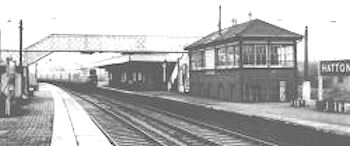 |
Extending the line built by the Great Western from Oxford to Banbury, the mixed gauge double track line from Banbury to Birmingham - including nine intermediate stations - opened on the 1st of October 1852. The Stratford-on-Avon Railway Company then made Hatton a junction station by building a mixed gauge single line from Hatton to Stratford-on-Avon in October 1860.
With the increase in passenger and goods traffic by 1892, the platforms were extended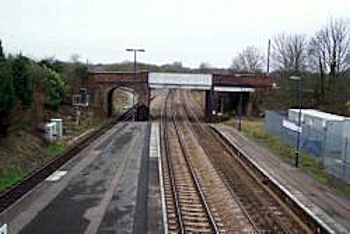 and refuge sidings were constructed, however in July 1897, the north avoiding curve was built for the Stratford branch eleviating the need for the locomotive to reverse around the Birmingham bound train. This meant the building of a new Middle and North signal boxes, and a new Branch signal box where the north curve left the Stratord branch. Two refuge sidings were also coverted to goods loops in 1901. and refuge sidings were constructed, however in July 1897, the north avoiding curve was built for the Stratford branch eleviating the need for the locomotive to reverse around the Birmingham bound train. This meant the building of a new Middle and North signal boxes, and a new Branch signal box where the north curve left the Stratord branch. Two refuge sidings were also coverted to goods loops in 1901.
1936 saw the construction of a new South signal box replacing the original South box and also the Middle signal box. To save confusion, the Branch signal box was renamed Hatton West in 1939. That year also saw the doubling of the line between Hatton and Bearley as the section from Bearley to Stratford had been doubled in 1907 in connection with the opening of the North Warwick to Cheltenham line.
Due to the rural location of Hatton station, the goods traffic from the area mainly consisted of fertilisers, animal feed stuffs and also livestock, however, with the improved road links, Hatton goods department closed in 1963.
As part of the West Coast Main Line, this section of line through Hatton station was rationalised from 1968. Firstly the north curve was singled followed by singling of the Hatton to Bearley branch. Finally, a new Power Box was built at Saltley bringing the closure of the three Hatton signal boxes on the 1st of September 1969.
|
| |
Kidlington
Origin: Great Western Railway
Opened: April 1855
Closed: Passengers - 2nd November 1962
Goods - 1st March 1965
|
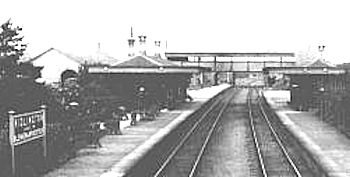 |
Initially named Langford Lane station until July 1855 and renamed Woodstock Road station, this was not the first station to be named Woodstock Road. The first Woodstock Road opened on the 2nd of September 1850 with the broad gauge single line from Oxford to Banbury, but with the opening of the second Woodstock Road station in 1855, this station was renamed Kirtlington. Later in 1890, the station was renamed Bletchington to avoid confusion with the similar sounding Kidlington.
The new Woodstock Road station was made a junction in May 1890, and renamed Kidlington, with the opening of the 3¾ mile branch line to Blenheim and Woodstock. Built and financed by the Duke of Marlborough, this line was worked by the GWR from the outset until the line was purchased by the Great Western in July 1897.
Expansion of the Kidlington station site began in November 1923 with the opening of a private siding for Oxfordshire Farmers that ran into a bacon factory. Later, Harris' of Calne took over the running of this operation. More additions were built at Kidlington in 1927 when additional sidings were provided, and then signalling alterations were made at both Kidlingon and Blenheim & Woodstock in readiness for the reduction of the branch to 'one engine in steam'.
An interesting arrangement at Kidlington concerned the movement of freight trains being shunted onto the branch line to allow other trains to pass. Naturally, this then blocked the use of the branch from Blenheim and Woodstock bound trains. With the increase in freight traffic during World War II, the Government paid for a loop to be built using the first ½ mile of the branch line.
Sadly, Kidlington suffered greatly from contraction and eventual extinction from the 1950's. Firstly, the Woodstock branch closed to traffic in March 1954, and the refuge siding was removed in June 1962. Passenger workings ceased from November 1964 and the closure of public goods services meant that all of the sidings - except for the siding into the bacon factory - were abolished. In December 1966, the private siding agreement was terminated.
Although the station site was quickly turned into an industrial estate, in the Spring of 2009, Chiltern Railways drew up a plan to return the station at Kidlington, although this would be sited at nearby Water Eaton.
The story of Kidlington station cannot end without mention of a terrible accident that occured to the Paddington to Birkenhead express on Christmas Eve in 1874. The 14 coach train was full when it arrived at Oxford and therefore a small four-wheeled carriage was slotted in behind the two locomotives. Travelling through the then named Woodstock Road station, the four-wheeled coach lost the tyre from its offside leading wheel but the drivers didn't become aware of the derailment for another mile. Shutting off steam and reversing both engines, together with the application of the tender brake caused the rear of the heavy train to close up heavily of the four-wheeled carriage, and this was smashed, in addition to the next nine coaches being throw onto the embankment. All together, thirty-four passengers lost their lives and sixty-nine passengers and staff were injured. The Board of Trade enquiry into the accident blamed the Great Western for the lack of braking over the whole of the train, and for the method of fixing the offending wheel tyre by using a practice that was outlawed in 1855.
|
Lambourn
Origin: Lambourn Valley Railway
Opened: Passengers - 4th April 1898
Closed: Passengers - 4th January 1960
|
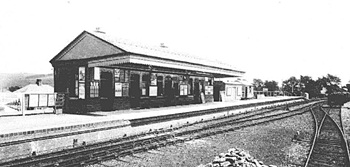 |
Severely delayed by a series of cash problems, the Lambourn Valley Railway was finally opened to the public in April 1898. Typical for stations on this single track line, the platform at Lambourn station was built to a height of just 9 inches and from the outset, it was operated and maintained by the Great Western.
In 1903 to enable the working of the line to be simplified, the GWR secured a Light Railway Order. This was principally because the 12¼ mile line operated with just "One Enginein Steam", and therefore did not require any signalling or passing loops. Then the Great Western took ownership of the line in July, 1905, and plans were immediately drawn up for improvements to the line. This modifications included rebuilding of Lambourn station from what was little more than a large shed, a small goods shed together with engine and carriage sheds. Platform heights were increased at all stations on the line to the standard height, and signalling was installed under the electric token system. Siding and passing loops were also provided at the various stations on the line.
By the mid-1930's passenger numbers had dropped due to the efficiency of the local bus services and in an attempt to win back business, railmotors was introduced on the line. With the ability to haul a horse box, these railmotors proved a big success. This however, meant the closure of the engine shed at Lambourn.
Closure of Lambourn station to passengers occured in January 1960 and the track was lifted by 1962.
Today, a large housing estate occupies the site.
|
| |
Leamington Spa
Origin: Great Western Railway
Opened: 1st October 1852
|
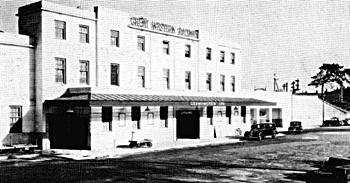 |
Although the line from Birmingham (later called Snow Hill Station) to Knightcote was authorised to the Birmingham and Oxford Joint Railway in 1846, a shortage of money meant that only the first stage of the line was built. The Great Western then took over the building of the line in 1848.
Originally the line would pass west of Leamington but powers were given to build the line through the town. The London and North Western Railway were already in the process of building a line to their Avenue Road station in Leamington and for the next two years, the GWR negotiated with the L&NWR to share the running line through the town and the station on Avenue Road - avoiding the need for two parallel viaducts. However, the L&NWR would not concede to either request.
The site chosen for the new station included Eastnor Terrace where a block of Georgian buildings stood. Completed in 1853, the platforms were built on an embankment with the broad gauge track approaching from the east carried by viaducts. A 60 feet overall roof covered the running lines supported by timber piles, although this roof was later removed in 1905.
The first significant improvements to Leamington station (renamed Leamington Spa in 1913) occured in 1901 with alterations to the narrow-gauge line through the station, lengthening of the platforms and a new goods shed. A larger engine shed was constructed in 1906 together with a Engine Shed signal box. This box was replaced in 1908 when the direct junction to the L&NWR line was opened. 1909 saw the opening of a carriage siding to replace the middle line in the station, which was then turned into a through line. Further carriage accomodation was provided in the old engine shed.
Further improvements were made in 1910 with the building of a North signal box, which used the new method of point detection (proven to be in the correct position) electrically. Unfortunately the rubber sheathing proved to be inadequate over time, and by 1921, this system was replaced by a mechanical detection method incorporating additional disc signals.
More improvements followed in the 1920's with the installation of a modern weighbridge, better access to the 'up' platform and modernising of the road leading to the station. A major rebuilding of the station was then put forward in 1934 which included a subway and new platforms. Work did not commence untl 1936 and was completed in 1939. The main building on the 'down' area of the station was 670 feet long and consisted of a waiting room, a large refreshment room and the stationmasters office. Above this floor was a hostel for the refreshment room staff. The opposite building on the 'up' side also contained refreshment and waiting rooms. The new platforms were 670 feet long of which 480 feet was covered, and 650 feet with a covered length of 360 feet. Electric lighting was installed in both station buildings and the subway, although the platforms retained the gas lighting system. The roadway to the main station building was enlarged and used seperate 'enter' and 'exit' lanes.
Improvements did not stop during the 1940's with the lengthening of both platforms, and new offices for the goods department and a staff canteen and even after nationalisation and renaming of the station to Leamington Spa General in 1950, things continued as before. The 1960's however brought major changes to both Leamington Spa General and to Avenue Road stations. The first part of the rationisation programme was removal of the link to the old L&NWR lines and the closure of Avenue Road station with removal of many sidings. The link to the ex-L&NWR line was reinstated in 1966 although at the other end of the station - at the same time that the station reverted back to be called Leamington Spa - however closure of the goods shed forced this traffic onto the roads.
From the middle of 1977, half of all trains travelling from Paddington to Birmingham New Street (Snow Hill station had closed by this time) were diverted to run through Coventry. Presently, almost all trains between the two cities run via Coventry, and things started to appear gloomy for the future of the station. However in 2011 and with the assistance of Chiltern Railways, Network Rail, The Railway Heritage Trust and Friends of Leamington station, the waiting rooms began the first stage of the refurbishment of the station to its former glory.
|
| |
Maiden Newton
Origin: Wilts, Somerset and Weymouth Railway
Opened: 20th January 1857
Closed: Goods - 5th April 1965
|
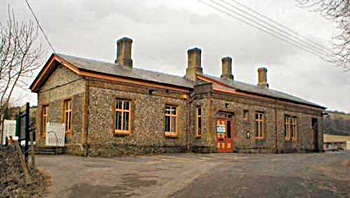 |
Maiden Newton was just one station of the broad gauge single track line that ran from Yeovil Pen MIll to Dorchester and later completed to its full length from Chippenham to Weymouth . It was built by the Wilts, Somerset and Weymouth Railway but worked from the begining by the Great Western. The station buildings were of flint construction with a long canopy, while the footbridge was of a lattice construction. A large goods shed occupied one of the other tracks at the station, and another set of tracks carried the branch line to Bridport and later to West Bay.
In 1925, the signal box on the 'down' (Dorchester-bound) platform was replaced by a new signal box at the end of the same platform. Upon nationalisation, the line was transferred to the Southern Region, who installed electric lighting on the platforms and green totem signs.
Rationisation in the 1960's made significant changes to the station which by the end of 1968, left a single track main line and the branch line to Bridport. This branch however was closed in May, 1975.
Today, Maiden Newton station is unstaffed although it currently services eight trains per day in each direction on weekdays and five trains on Sundays. The station building and the signal box have also been awarded listed status.
|
| |
Maidenhead
Origin: Great Western Railway
Opened: 4th June 1838
|
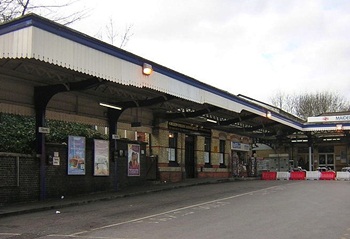 |
The original station at Maidenhead was built a mile from the town centre close to Dumb Bell bridge over the Bath Road (close to the present Taplow station). The purpose of this location was so that the railway could take passengers from the busy coach traffic that travelled between London and the West Country. Built using two platforms and wooden buildings, it was very successful at 'tapping' into this market. Another consideration was that although Brunel's Maidenhead Railway Bridge was completed in 1838, it was not brought into use until 1st July 1839. It is thought that the Great Western board of directors did not believe that the bridge - due its flat design - would not hold the weight of the trains, and ordered Brunel to leave the wooden formwork used to construct the arches in place. Realising their error in serving the town though, the Great Western planned a move nearer to the centre of Maidenhead, but this did not take place until 1871. Meanwhile, in 1854, a station was built on the Wycombe branch line to serve the town.
The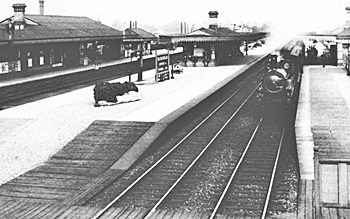 new Maidenhead station was opened on the 1st November 1871 and this resulted in the closure of the old station and the Wycombe branch station (renamed Maidenhead (Boyne Hill). Originally, the new station was built as a double track broad-gauge line, but the track between Reading and Maidenhead was quadrupled during 1890 to 1893. This change created an additional platform and a seperate goods station. Three signal boxes - Maidenhead East, West and Middle - controlled movements in the area of the station. new Maidenhead station was opened on the 1st November 1871 and this resulted in the closure of the old station and the Wycombe branch station (renamed Maidenhead (Boyne Hill). Originally, the new station was built as a double track broad-gauge line, but the track between Reading and Maidenhead was quadrupled during 1890 to 1893. This change created an additional platform and a seperate goods station. Three signal boxes - Maidenhead East, West and Middle - controlled movements in the area of the station.
By 1923, it was noticed that the Maidenhead East signal box had been affected by subsidence, and therefore a new East signal box was built opposite the old box. A major programme of improvements in 1926 introduced a luggage subway, a parcels office and a larger refreshment area.
Introduction of multiple aspect signalling from Slough meant the closure of all three Maidenhead signal boxes in 1963, however a new signal box was created to serve the branch line to Wycombe. The goods yard was lifted in 1966, however the goods shed itself remained for private traffic. The new signal box was closed in 1974 when control of the Wycombe branch was passed to Slough.
|
Copyright © by John Daniel 2013.
|








 and refuge sidings were constructed, however in July 1897, the north avoiding curve was built for the Stratford branch eleviating the need for the locomotive to reverse around the Birmingham bound train. This meant the building of a new Middle and North signal boxes, and a new Branch signal box where the north curve left the Stratord branch. Two refuge sidings were also coverted to goods loops in 1901.
and refuge sidings were constructed, however in July 1897, the north avoiding curve was built for the Stratford branch eleviating the need for the locomotive to reverse around the Birmingham bound train. This meant the building of a new Middle and North signal boxes, and a new Branch signal box where the north curve left the Stratord branch. Two refuge sidings were also coverted to goods loops in 1901. new Maidenhead station was opened on the 1st November 1871 and this resulted in the closure of the old station and the Wycombe branch station (renamed Maidenhead (Boyne Hill). Originally, the new station was built as a double track broad-gauge line, but the track between Reading and Maidenhead was quadrupled during 1890 to 1893. This change created an additional platform and a seperate goods station. Three signal boxes - Maidenhead East, West and Middle - controlled movements in the area of the station.
new Maidenhead station was opened on the 1st November 1871 and this resulted in the closure of the old station and the Wycombe branch station (renamed Maidenhead (Boyne Hill). Originally, the new station was built as a double track broad-gauge line, but the track between Reading and Maidenhead was quadrupled during 1890 to 1893. This change created an additional platform and a seperate goods station. Three signal boxes - Maidenhead East, West and Middle - controlled movements in the area of the station.